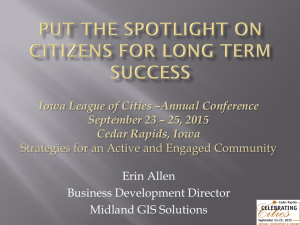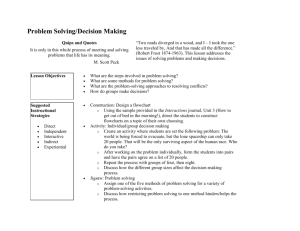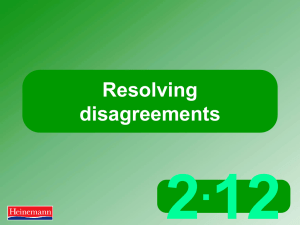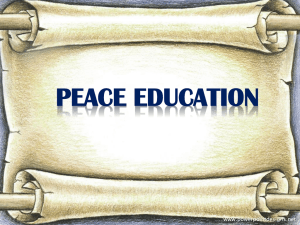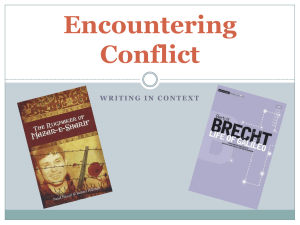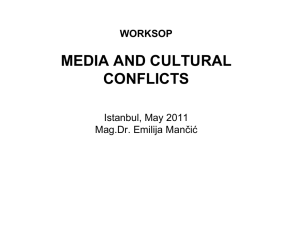PPT File - Carmichael Centre for Voluntary Groups
advertisement
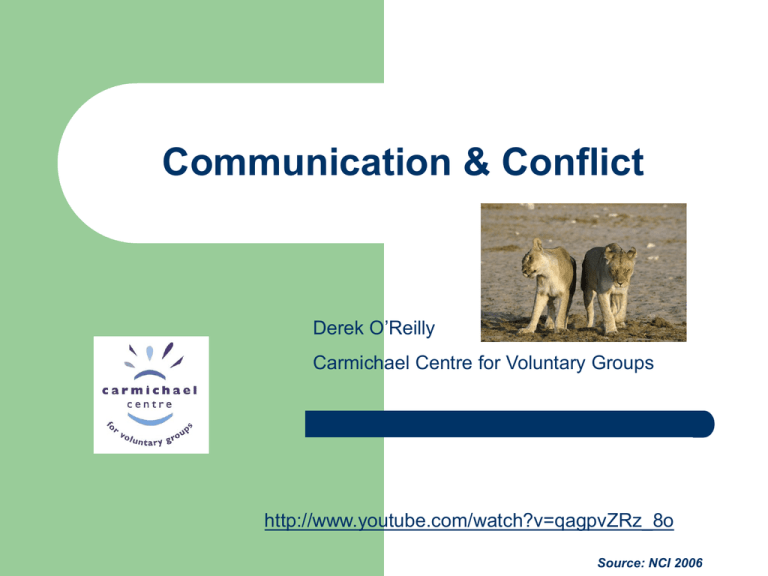
Communication & Conflict Derek O’Reilly Carmichael Centre for Voluntary Groups http://www.youtube.com/watch?v=qagpvZRz_8o Source: NCI 2006 Effective Communication Effective Communication Words 7% Voice 40% Body Language 53% Developing good communications skills helps us promote effective relationships and saves time! Barriers to Effective Listening Mind reading Day-dreaming Checking text messages Worrying about home Arguing/disagreeing Jumping to conclusions Rehearsing your next question Switching off mentally when you disagree Bias and prejudice The ‘Halo Effect’ Effective listening and questioning allows you to move beyond facts and data to uncover a person’s feelings, values and beliefs Handout: Measuring your Communication Skills Listening Ability to get your message across Ability to “read” others Emotional management Assertive communication Good communication habits In pairs, discuss and rate your communication skills Understanding Conflict Intra-personal Inter-personal Inter-role Inter-organisational/group Inter-community International Common Sources of Conflict A range of factors can determine whether conflicts will arise or whether our working relationships with others will be harmonious – – – – Unclear definition of responsibilities: Occasions where conflict arises because of decisions or actions taken in disputed territories outside of their remit Limited resources: Competition for resources of time, money, space etc. may lead to interpersonal conflict Conflict of interest: Individual prioritise their own personal goals ahead of the company objectives CONFLICT WITHIN AN ORGANISATION Conflict is not uncommon. Minor disagreements or heated discussion are inevitable aspects in most organisations. Conflict may well be a sign of a healthy organisation. There should be clashes of ideas about tasks and projects and disagreements should not be suppressed but be brought out into the open and be discussed and all issues explored and conflicts resolved. CONFLICT WITHIN AN ORGANISATION Conflict becomes counter productive when it is based on personality clashes or when it is treated as an unseemly mess that needs to be hurriedly cleared away rather than resolving the main issues Often conflict resolution strategies fail because the individuals involved are unable or unwilling to resolve the conflict. If a conflict cannot be resolved, other options should be investigated such as a formal complaint or grievance procedure, external mediation etc. Problems in Conflict Management 1. 2. 3. Parties will avoid conflict. Act as if there is nothing wrong leading to even greater problems in the future and drives the conflict “underground” where it’s harder to fix. The blame game. People engage in finger pointing and personalise the criticism e.g. he’s such a Wally (or worse!!) Adopting a win/loose mentality. Individuals seek victory in the conflict and are not easily prepared to compromise. Avoid a Defensive Climate Evaluation: Judging or criticising others Control: Imposing the will of one on another person or group Strategy: Hidden agendas Neutrality: Showing indifference or lack of interest Superiority: Expressing dominance due to rank or status Certainty: Being rigid in one’s willingness to listen and pre-judging the outcome Promote a Supportive Climate Descriptive: Presenting ideas or opinions. Problem orientation: Focusing attention on the task. Spontaneity: Communicating openly and honestly. Empathy: Understanding the other person’s thoughts. Standing in their shoes Equality: Asking for opinions and/or advice. Provisionally: Expressing a willingness to listen to the ideas and thoughts of another. Conflict can be constructive: Recognised that if properly managed it can have a positive impact on the team. Be prepared: Plan how you will communicate about conflict in order to create a supportive climate in the work place. Be involved: Do not withdraw or avoid conflict but rather constructively search for solutions. Framework for Discussing Problems If solutions are to be developed by problem solving, they have to be generated by those who share the responsibility for seeing the solutions work. 1. 2. 3. Firstly, those concerned work to define the problem and agree on the objectives to be attained in reaching a solution. alternative solutions are generated and their merits are debated. agreement is reached on the preferred course of action and how it can be implemented. Framework for Discussing Problems The following sequence of five questions will allow the issues to be fully teased out: 1. 2. 3. 4. 5. Can you describe the problem or the situation to me? How is this currently impacting on you? If nothing changes, what are the implications? What’s the ideal outcome for you? What are the next steps and when should I follow up with you? Having given people the opportunity to make their views known you may well be surprised at the simplicity of the solutions offered Resolving Conflicts Don’t avoid conflict altogether by pretending it does not exist. Resolving should be characterised by co-operation, mutual respect and teamwork. Disputes can sometimes become emotional. Don’t lose track of the main issue. Keep people focused on the real issue. Don’t let a dispute become personal and do not tolerate bullying, harassment or humiliation Resolving Conflicts There are three possible solutions: 1. Accommodation- can work but make sure you are not losing sight of team or organisational goals. 2. Find a win/win solution- where every one is a winner. 3. Compromise- where each party recognises the need to make concessions. “The difference between the right word and the almost right word is the difference between lightning and a lightning bug” Mark Twain Managing problem behaviour at meetings – Pair work: discuss possible solutions: Nobody says anything People have side conversations One person dominates A row breaks out! Discussion goes round in circles Cool or hostile atmosphere Handling Complaints Be Nice! Use your EARS and your EYES and not your MOUTH! Aggressive Complainers Aggressive Complainers need: Someone to take notice Permission to let off steam Explanations not excuses To get back in control A solution They don’t want: To be patronised To be denied their feelings Shouting back An argument Denial and justification Authoritative behaviour Aggressive Complainers What should you do? 1. Understand the feelings behind it Calm the person down- talk quietly Don’t become hostile or offensive Stay focused on the problem Show the person you are taking it seriously Aggressive Complainers 2. Find a solution Establish the facts of the problem Involve the client – what do they want of you Discuss alternatives if necessary Take action and follow - up Handling an Angry Phone Call Listen actively – give feedback Keep your voice calm and even Don’t be tempted to attack or patronise Don’t roll your eyes or drum your fingers! Don’t put the phone down in temper Handling an Angry E-mail or Letter Put it to one side for a while – let your temper cool Stick to the facts in the reply Don’t reply with inflammatory language Be very polite and considered Ask someone to check your reply before it is sent Passive Complainers Type A: Don’t say anything: Create the chance to ask open questions and show you welcome complaints Type B: Use mind games to make their point and poisonous (unexpected) little barbs: Don’t be intimidated. Don’t despair, and don’t react. Bring them back to the facts! Constructive Complainers Don’t dismiss their ideas Thank them for their suggestions Put right what you can Groupwork Develop 6 ways to deal effectively with conflict…
